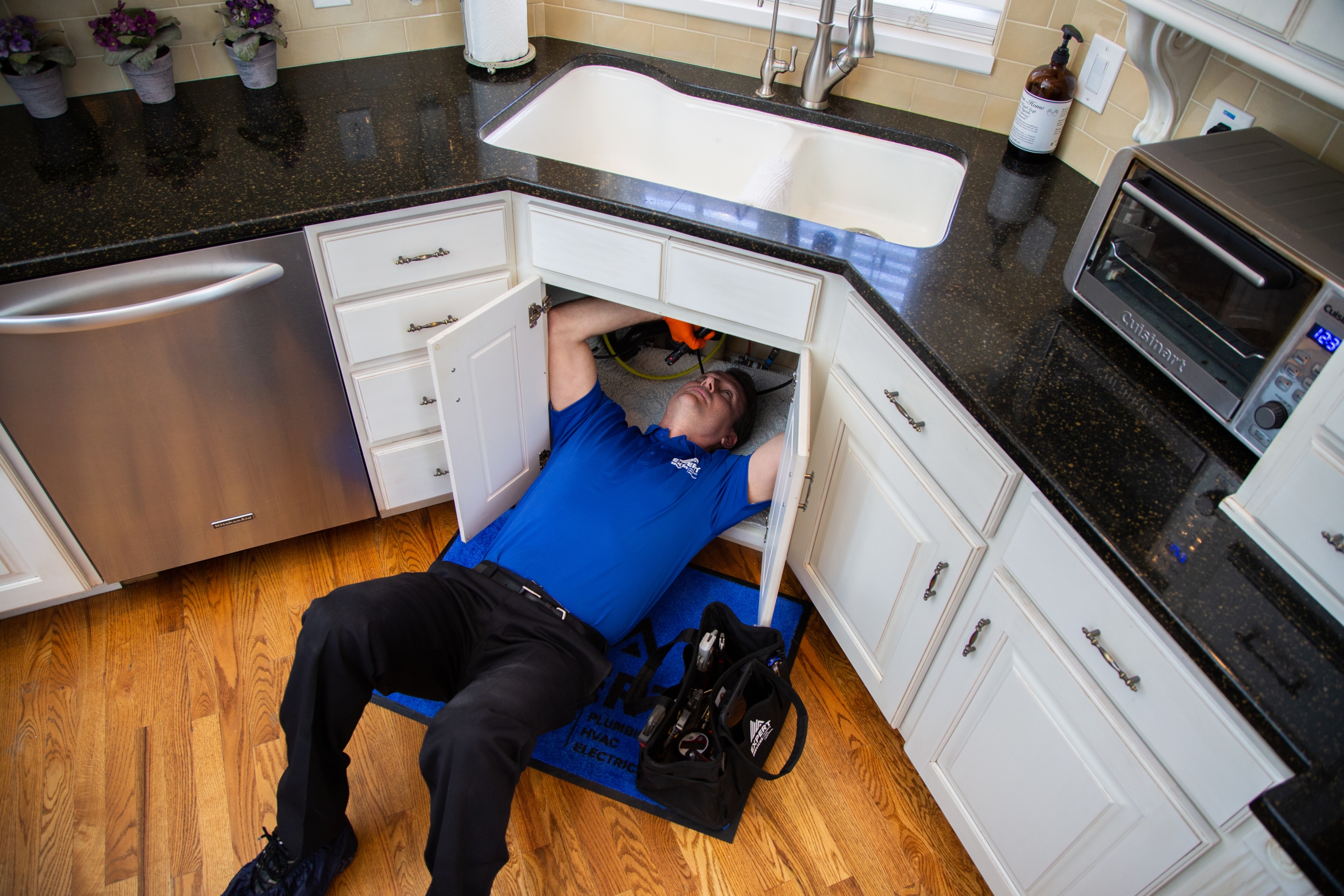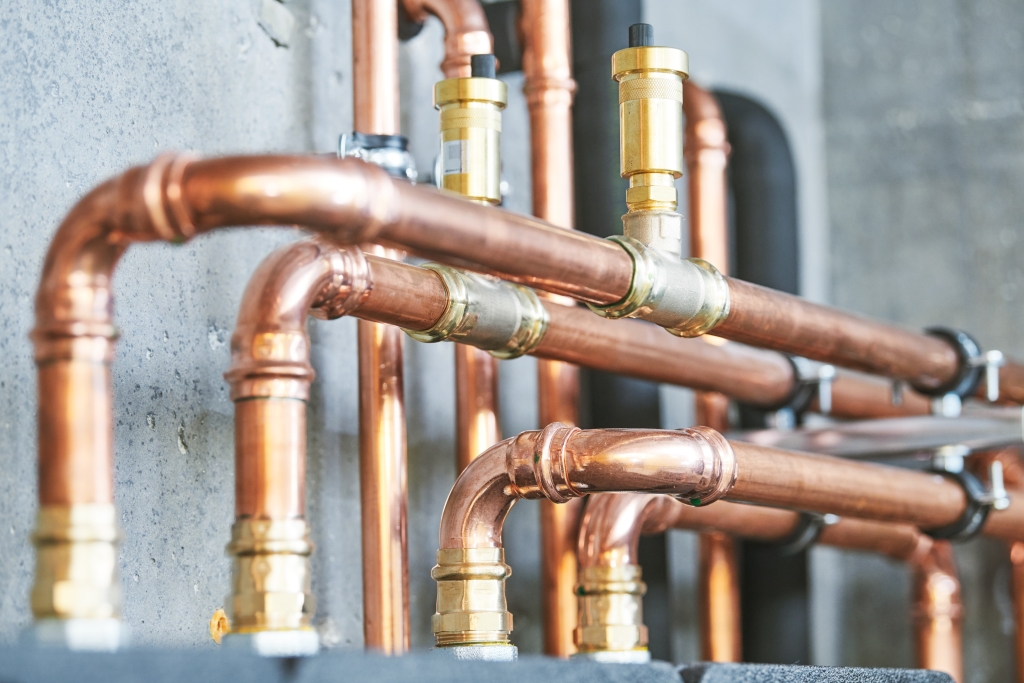Today we’ll be discussing common types of piping and how they’re used within your home’s plumbing system. And if you’re deciding to repipe your home, or you’re building a new home or an extension onto your current house, we hope this helps you in deciding the plumbing system that’s best for you.
The two water systems of your home are as follows. The drainage system–the outgoing water–includes what your sink, shower, and toilet drain into. The potable system feeds water to all the parts of your home, but it’s a one-way system. Potable enters your home into all of your taps and then leaves your home. This is what makes it “one way.”
Potable water means you can drink the water; it’s non-toxic. But once the water goes into the drain, it’s no longer potable.
Why Do I Need to Know About Plumbing Systems?
Most people don’t know the differences, benefits, or drawbacks of each plumbing system. But our customers want to know this information to get an understanding of their home’s plumbing systems and what kind of system may better suit their needs.
For example, if one of our customers needs their current water system replaced with newer pipes, this is called a “repipe.” You could need a repipe if you’re wanting a larger volume of water fed through your system or perhaps your home’s current system is leaking and breaking down. Knowing what kind of system you have and what kind you want can determine the kind of repairs and replacements that are possible.
Also, our technicians may ask what type of piping you currently have, and this is so we can know what kind of material needs to be bought, replaced, or repaired. Differences in price, preference, and utility come into play here.
First things first. What is a plumbing system and what does it entail?
So what is a plumbing system? Let’s break this down. A “plumbing system” refers to the pipes that carry water to your faucets, showers, and waste disposal systems (aka your toilets). Expert Services- Plumbing, Heating, Air & Electrical has been serving Utah with quality plumbing for decades, and we’ve seen how these systems have evolved over time into more advanced solutions.
Each type of piping serves a different purpose within your home. We cover that below.
PVC Piping
PVC (polyvinyl chloride) is a hard but semi-flexible pipe. It is the most common type of pipe used in irrigation and sprinkler systems and can also be found in drainage systems.
In fact, drainage systems in PVC are a great option. PVC piping has a smooth interior lining, so it’s less prone to build-up, which can increase draining functionality and make the system quieter.
It’s also chemically resistant, which matters when you’re using some kind of chemical or acid to clear the drain. If you had a copper line, the acid could react badly to the copper but PVC is chemically neutral so cleaning chemicals or acid wouldn’t damage the PVC piping.
Temperature and pressure are also factors with PVC piping:
- If it gets too hot, it will cause the actual plastic to break down, essentially softening the piping and crumbling. PVC piping is also more susceptible to warping due to hot water.
- PSI (pounds per square inch) is the water pressure inside your pipes. We’ve noticed when PVC transitions to different material or at threaded fittings, leaking can occur with more pressure. If the PSI gets too high, PVC piping can start to crack and burst.
CPVC Pipes
CPVC (chlorinated polyvinyl chloride) is another member of the PVC piping family. It’s generally not used in colder environments, but it can be used for hot water lines inside of homes.
This is because it is able to withstand a higher temp than PVC: where PVC can handle around 140 degrees, CPVC can withstand around 200 degrees Fahrenheit. It can handle cold water temperatures, but an external temperature that’s too cold can lead to cracks and brittleness within the pipe.
Because of its higher tolerance to heat, it’s often used for potable water distribution. It’s not generally used for the draining system. It has more industrial than residential uses, such as smaller fire suppression systems, corrosive fluid handling, and water distribution. So, our Experts aren’t usually installing CPVC piping in Utah’s homes.
PEX A and PEX B Piping
First, let’s talk about the grandfather of PEX piping: polybutylene piping. Because of the low cost of material and easy installation process, it was used primarily during the late 70’s to mid 90’s. It has since been recalled due to a high failure rate. Polybutylene is a gray pipe that looks very similar to PEX but can be very brittle and fragile.
We highly recommend that if you have polybutylene piping, you consider repiping your home. When performing spot repairs, Expert Services- Plumbing, Heating, Air & Electrical will try to remove as much as possible in the area in order to avoid future issues. This pipe is notorious for splitting up the line even when attempting to repair.
PEX A is a soft, flexible pipe made of Cross-Linked Polyethylene
Throughout this explanation, you’ll hear us refer to “fittings.” Fittings are what connects the pipe to each other, to make turns, to make offshoots to different systems.
The main reason to use type A is that there’s no flow restriction. It can be expanded over a fitting and the plastic itself will compress itself over a fitting as it contracts to its original size.
The ergonomics (how easy something is to use or access) of PEX A and PEX B piping is a significant factor. For example, sometimes you might have to put a fitting into a tight spot, making it easier to use type A because it’s more flexible and likely to connect the piping in tighter spaces, such as behind a wall.
Both types–A and B–work well in hot and cold environments. Type A, though, becomes more malleable when it’s warm and less malleable when it’s cold. Type B is stiffer and can be flexible but it’s not as flexible as type A.
If you want to upsize your system, that means you want to increase your water flow. The bigger the pipe, the more water will be fed through. You can use both PEX A and PEX B piping for upsizing.
PEX A is less readily available and less common in Utah, as it can be up to twice the material cost.
PEX B Piping is also made of Cross-Linked Polyethylene, but it has a slightly different manufacturing process.
The differences between types A and B are in their flexibility and the way they’re connected. There are also pricing differences between the two.
Type B uses a crimping system to connect to pipes. It’s also a little thicker and not as flexible as type A.
The way you connect type B is with an external clamping force using a crimp ring (either copper or steel) that goes around the outside of the pipe. You then use a “crimper” tool to crunch the ring around the outside of the pipe and connect it to the fitting.
Because PEX B doesn’t require an expansion tool, the joining method is faster and simpler than the process for PEX A. But the joining method isn’t as ergonomic as PEX A: if the crimp tool isn’t square on the sleeve, you can crimp it unevenly and cause a leak.
Copper Piping
Copper is a non-flexible hard pipe that’s good for providing rigidity and lessening the chances of breaking a water line or causing a leak in the line.
There are diff types of copper piping, which vary in their wall thickness. The thicker the piper, the more expensive, but the longer it’s going to last. When the piping is thicker, it can also handle a higher PSI.
Because it is made of a metal material, copper pipes can corrode over time. They’re non-flexible, so it’s less likely to be used in tight spaces. You’re likely to use copper piping where you want stiffness in your piping system. You want stiffness and rigidity in your piping to reduce vibrations caused by water flow as well as the sound water running through your home’s systems.
If the piping is not properly installed, or if there is hard water or harsh chemicals in the water, this can create pinhole leaks in copper piping over time.The cost of copper is also significantly higher nowadays and more time-consuming to install. And unlike PEX piping, copper pipe has a high likelihood of splitting and bursting if they ever freeze.
Galvanized Piping
What is galvanized piping? It is a steel pipe that has been galvanized, which means it has a coating of either zinc or some other coating that provides resistance to corrosion. The galvanized coating gives it resistance to corrosion, and that is how the name of this piping came to be!
Galvanized piping is quickly becoming obsolete because it is more likely to corrode and cause leaks over time. It is often found in older homes when newer piping solutions were not yet available.
Drawbacks of galvanized (steel) piping are that it builds up rust and minerals and chemicals build up on the inside of the pipes. Both copper and galvanized pipes are prone to rust and corrosion over time, so most have been swapped for copper or plastic pipes in residential plumbing repairs.
Typically, galvanized piping is going to be used only in industrial or commercial cases. But if you request that the galvanized piping in your home be repaired, we gladly will!
So What Plumbing System is Best For You?
When needing replacements or repairs to your current piping system, our professionals will go to your home, see what your needs are, what you have and don’t have system-wise, and more. There are many different factors in determining what will be best for you and your home. Hence why it’s so important to speak to a knowledgeable and experienced plumber from Expert Services- Plumbing, Heating, Air & Electrical.
Some factors we consider when determining the best plumbing system for your Utah home:
- How much water your family needs
- How hot or cold the water in your system is going to be
- How high the city’s pressure from the incoming line is
- How big your home is
- The current piping system you have
- Your budget and other preferences
- Your city’s plumbing ordinances
Finding the best plumbing system for your home is a complex order. There are different types of piping within the home that serve different purposes.
Leave this to the Expert Services- Plumbing, Heating, Air & Electrical. We work to figure out the intricate, detailed needs of your home and the kind of piping that will best serve you and your family’s water needs. Give us a call to get service from one of Utah’s top plumbing providers.
Sources: https://www.thisoldhouse.com/plumbing/21312425/types-of-plumbing-pipes


